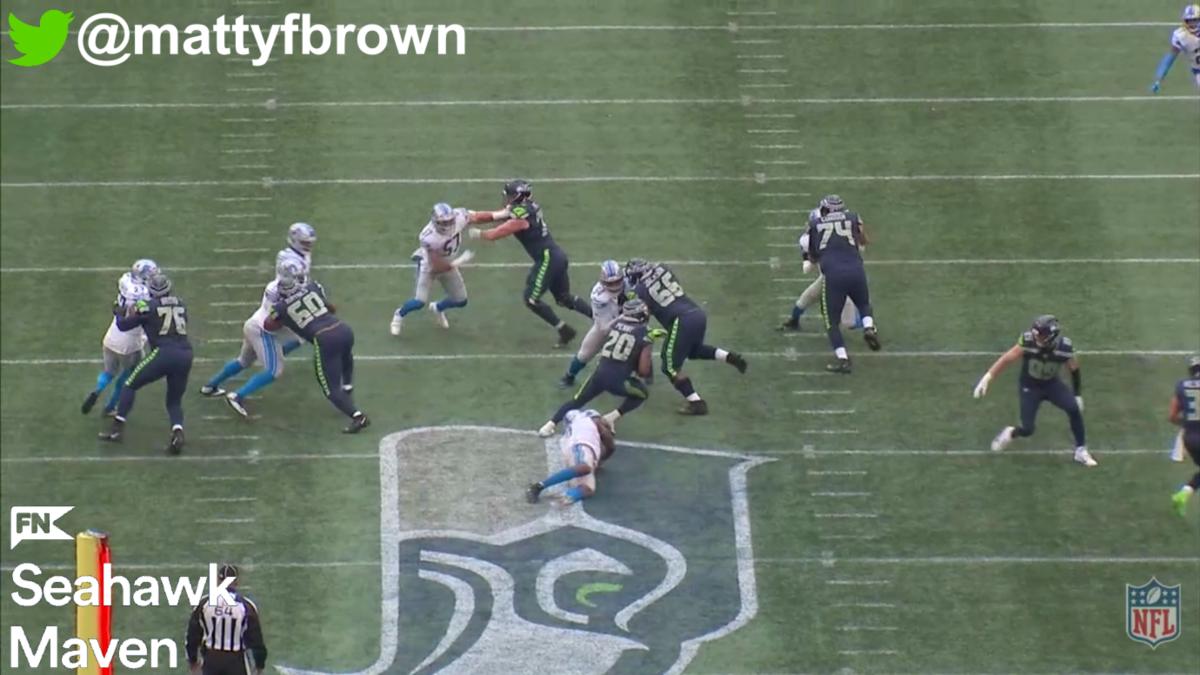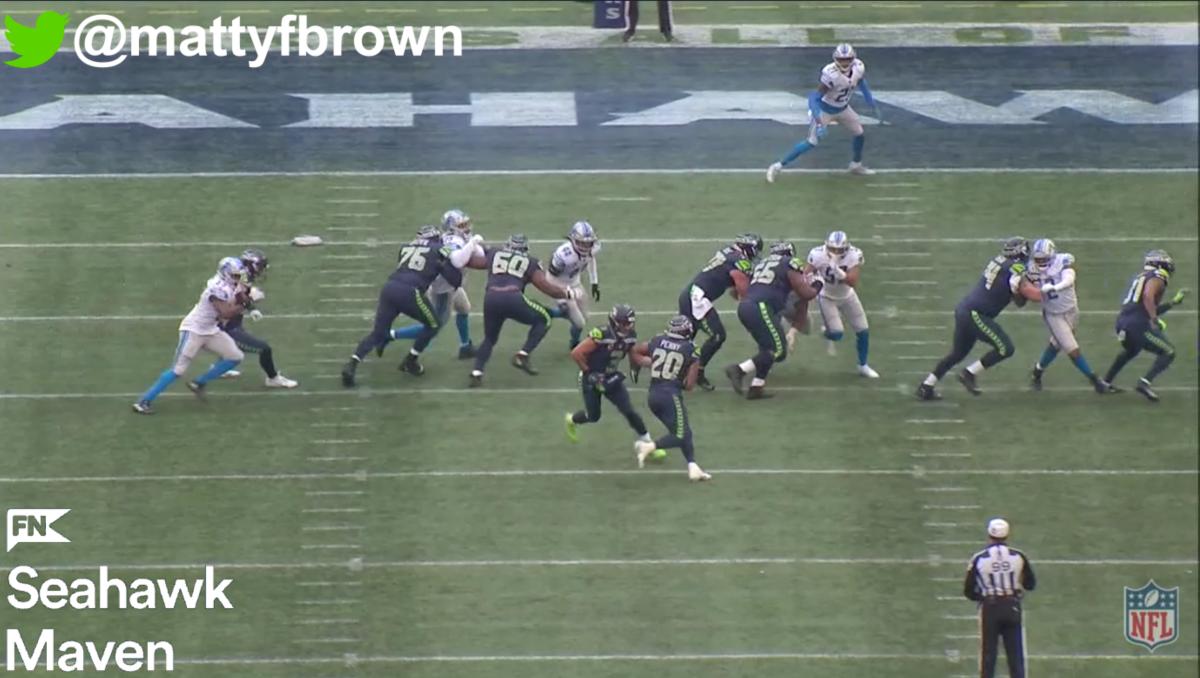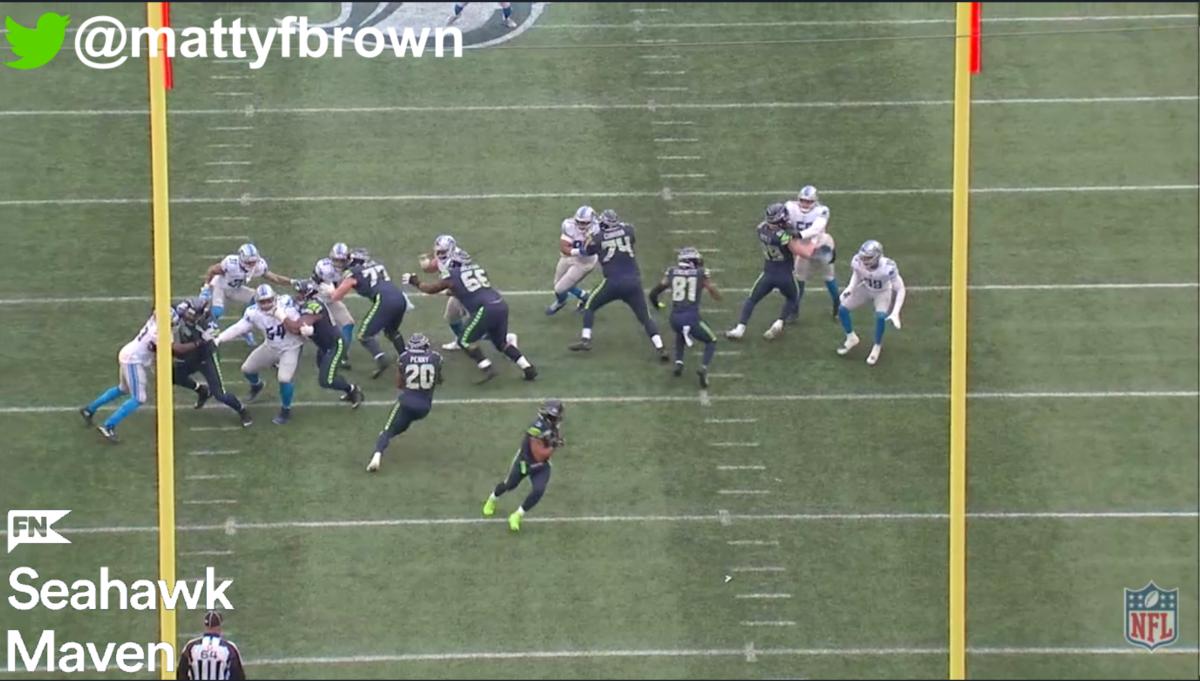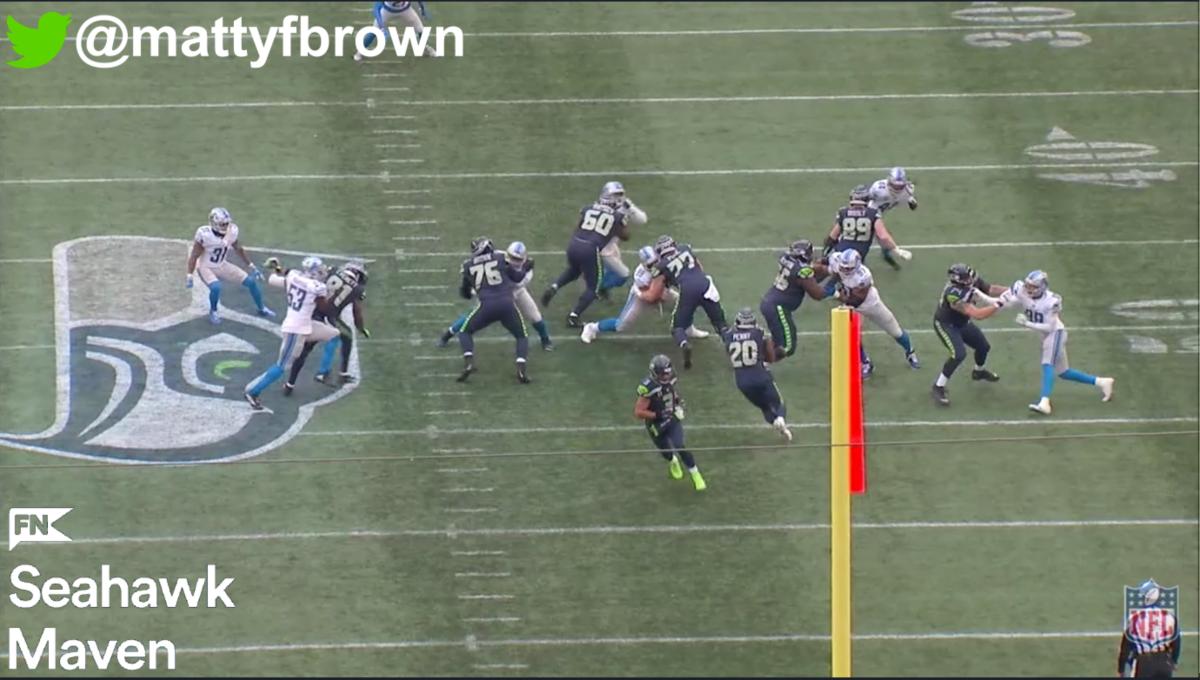Seahawks Blocking For Historically Efficient Run Game
The fantastic Seahawks run game has pulled Seattle’s offense out of the pit of misery. The lead star, running back Rashaad Penny, put up his most dominant performance yet in Week 16 of the 2021 regular season and was named NFC Offensive Player of the Week for his efforts. As such, the fourth-year ball carrier will naturally receive most of the focus.
However, the excellent play of the Seahawks’ offensive line must also be highlighted. The team's latest victory, coming via a 51-29 blowout of the Lions, was a continuation in some superb run blocks and they arrived from backup players. Seattle has found something.
But first, let’s look at Penny’s numbers to illustrate his brilliance. Prior to 2021, Penny had never rushed for 130 yards in a game. He’s now met that mark in three of the last four weeks. In that quartet of games, Penny has rushed for 481 yards and five touchdowns, averaging 6.97 yards per attempt on the 69 carries. The next highest total over that span is MVP candidate Jonathan Taylor with 386.
Penny is also in the company of the Colts running back when it comes to big runs: while Taylor leads the NFL with eight runs of 25-plus yards, Penny has six. And yet Penny has achieved this on just 87 carries compared to Taylor’s 317 attempts. Penny’s explosive ability remains obvious.
Per Next Gen Stats, Penny has 197 rushing yards over expectation since his Week 14 start against the Texans. That’s double the RYOE of any other NFL running back in the four-game time frame. Comparing this to Seattle’s season-long Pro Football Focus run block grade implies that Penny’s success is largely a result of his own play and not the Seahawks’ offensive line.
Sorry Jonathan Taylor, you've been dethroned pic.twitter.com/Mx8EqwSzDZ
— Computer Cowboy (@benbbaldwin) January 4, 2022
On the season, Penny is averaging the most rushing yards after contact per attempt, according to Pro Football Focus. Asides from emphasizing his athletic ability, this is an additional indicator of Penny thriving in spite of the situation up front.
Let’s quickly dismiss this implication and use the film to credit Seattle’s “maulers," as described by Lions defensive coordinator Aaron Glenn in the build-up to the game.
This is an excellent clip to start with as it shows Penny’s ability to run through tackles in addition to the offensive line putting in work. Tight end Will Dissly missed his split-zone, sift block kicking out the backside end man on the line of scrimmage, Austin Bryant. Penny, though, weighs 236 pounds, according to head coach Pete Carroll. The back was able to slip off Bryant’s pursuit and then jump cut back through the opening.
The offensive line dominated this split mid zone rep. Left guard Phil Haynes, the 2019 fourth-round pick making his first NFL start, bodied 3-technique Levi Onwuzurike, his hand placement tight inside causing serious movement out of the B-gap. Center Ethan Pocic checked the first level before climbing to linebacker Anthony Pittman and fitting him away from the cutback. Right guard Gabe Jackson was able to reach block the 2i-technique Alim McNeil, washing him down the line of scrimmage.

Particular attention should be paid to the work of right tackle Jake Curhan. The undrafted free agent checked Bryant was not penetrating inside, then climbed onto second level linebacker Jalen Reeves-Maybin. From there, he stuck on, widening the linebacker to the outside and expanding the hole for Penny to run through.
The Lions played two-high coverage and yet the second-level defenders did not fall back with Dissly’s block as though it were two-back, meaning that Seattle maintained the numbers and angles advantage into the cutback lane. Detroit ended with Pittman and nickel A.J. Parker in the same gap while Reeves-Maybin was mauled. More important from a Seahawks perspective: the offensive line and back executed, and they were rewarded with a 20-yard gain.
— Ultra Rare Tape (@UltraRareTape) January 7, 2022
Next we have Penny’s 15-yard touchdown run, which arrived via 12 personnel to bully Detroit’s nickel choice. The frontside of the offensive line achieved decent movement running this to the 2i nose tackle, but the real key arrived on the backside of the play—the spot where Penny cut the run back.
Left tackle Duane Brown and Haynes showed familiarity beyond their limited playing time together. Brown was able to take over Haynes’ block of Onwuzurike just in time. Haynes had to leave the defensive tackle because the linebacker, Reeves-Maybin, was looking to run through the backside A-gap for the tackle for loss. Haynes managed to get on Reeves-Maybin while Brown got enough of Onwuzurike in the B-gap.

In the C-gap, Will Dissly had looked to reach block head-up defensive end Charles Harris. Dissly was surprised by Harris’ back-door movement during the play. The defensive end, looking to penetrate backside, left the Lions without a player in the C-gap given the cornerback aligned out wide, Will Harris, stayed outside following the shift of tight end Gerald Everett across the formation. While Harris did beat the block, he faced a tough tackle on an at-speed Penny. Hitting Penny high, Harris bounced off the running back while leaving nobody in the C-gap for the touchdown.
Penny was then able to cut past deep safety Tracy Walker at speed, his thigh bouncing off Walker’s arm attempt.
— Ultra Rare Tape (@UltraRareTape) January 7, 2022
The Detroit game was not a day of Penny being regularly contacted in the backfield. This 1st and 10 carry versus the Lions' base personnel and bear front saw the run blocking create an excellent lane on their 12 personnel split zone concept.
Curhan dominated the 4-technique in front of him, aiming left and straining to move Nicholas Williams firmly in the shrinking B-gap (this type of block versus a head-up defender is fast becoming his trademark).
Meanwhile, tight end Dissly reached C-gap linebacker Derrick Barnes, reacting well to turn the rookie outside. Everett’s sift block across the formation dealt with the edge presence of defensive end Julian Okwara, with the off-the-line-of-scrimmage blocker suitably adapting his aiming point to the constricting force technique of the defender.

As a result of Curhan’s work to the inside and the tight ends outside, Penny had a huge crease to hit in between and his speed took the opportunity for 13 yards.
— Ultra Rare Tape (@UltraRareTape) January 7, 2022
Pocic often receives double team help in concepts. However, on this 23-yard Penny carry, Seattle’s blocking scheme left Pocic one-on-one versus Detroit’s head-up nose tackle in another bear front, base defensive look. The 320-pound Pocic was up against John Penisini, listed at 335 pounds. Blocking the wide zone, Pocic was able to get outside leverage on Penisini and then anchor, dropping his knee to absorb the blow before locking out to seal Penisini on the inside.

This was a crucial block from Pocic, as it allowed Haynes to immediately climb to the pursuing backside linebacker, Barnes. As Barnes looked to play off Penisini, he was met by Haynes. The guard pushed Barnes all the way out of the play and Penny—cutting off the well locked-out Jackson at right guard and Pocic at center—enjoyed the opening.
— Ultra Rare Tape (@UltraRareTape) January 7, 2022
So, the tape shows that running back and offensive line are working together to create a beautiful run game.
"They deserve it all more than I do,” Penny made sure to praise of the line in his post-game press conference.
Credit must also be apportioned to offensive line coach Mike Solari and run game coordinator Andy Dickerson.
Nathan Ernst of Hawkblogger's work shows the run game to be staggeringly efficient, almost as much as passing.
After being extremely boom or bust early, Seattle's run game has outperformed dropbacks across the league in EPA/play for the last 5 weeks. And by a fair margin.
— Name cannot be blank (@NathanE11) January 5, 2022
If they could build/maintain this type of rushing attack then it'd change the math on how often they should pass. pic.twitter.com/z8b8j4T0mn
Seattle has been rushing roughly as effectively as your average Aaron Rodgers game the last two weeks. Pretty good! pic.twitter.com/ADdvpOsXN2
— Name cannot be blank (@NathanE11) January 5, 2022
Unlike the Bears game, where eight of the team's 20 running plays featured one puller or more (40 percent) and two more of the plays were duo (50 percent gap-blocked), Seattle returned to more zone versus Detroit. The Seahawks called 29 runs and yet, just six of the runs featured one puller or more while two were duo (28 percent gap-blocked). Whatever the chosen scheme, Seattle’s combination block chemistry and execution has noticeably improved—especially on the interior.
The last time we witnessed this kind of efficiency was Shane Waldron’s previous coaching stop; the 2018 Rams ground attack. It is unlikely that Seattle can sustain this high level, however, and Detroit was a particularly bad opponent.
Nevertheless, the Seahawks being able to run the ball so well has been a key to their recent offensive success and an element that, while likely to somewhat worsen, will hopefully continue into 2022 with enough effectiveness.
